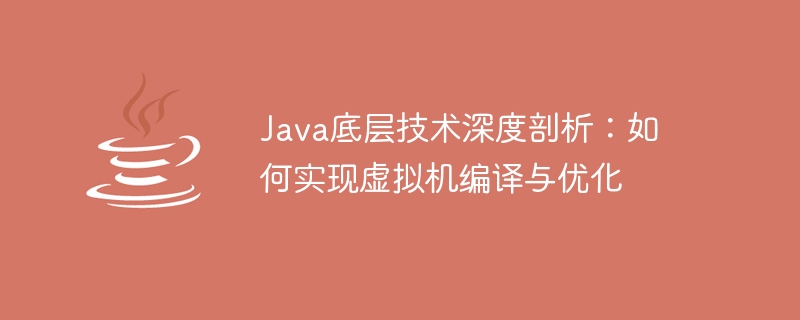

Java is a widely used programming language. Its underlying technology involves many aspects, among which virtual machine compilation and optimization is a very important aspect. In this article, we will take an in-depth look at compilation and optimization techniques for the Java Virtual Machine, including code examples.
What is virtual machine compilation and optimization?
Java programs do not run directly on the operating system, but run through the Java Virtual Machine (JVM). In the JVM, Java programs are compiled into bytecode, which is converted into machine code by the JVM at runtime. Virtual machine compilation and optimization refers to the process of optimizing the execution efficiency of Java programs so that they can run faster and more efficiently.
Java programs can be compiled in two ways: static compilation and dynamic compilation. Static compilation means that the Java code is compiled into local machine code in the compiler, so that the program can be run directly; while dynamic compilation means that at runtime, the JVM compiles the Java code into machine code on demand, so that the program can be run according to actual needs. The situation is optimized.
After the first compilation of a Java program, the optimal execution efficiency may not be obtained. Therefore, virtual machine optimization is a kind of optimization performed when the program is running. It can adjust the execution strategy of the program and use the characteristics of the hardware to improve the performance of the program.
JVM’s compilation and optimization mechanism
There are three main JVM compilation and optimization mechanisms:
When Java When the program is executed for the first time, the JVM will parse the Java code into bytecodes and execute them one by one during runtime. Although this method is slower, it is very convenient for small programs or test programs.
Just-in-time compilation means that when the program is running, the JVM can compile the Java code into local machine code according to the actual situation and save it in the local cache middle. In this way, the next time the same code is executed, the local machine code can be run directly, avoiding the time consumption of recompiling.
Optimization compilation is an optimization performed by the JVM based on just-in-time compilation, which can improve the execution efficiency of the program in a variety of ways. Among them, the most common way is to use a JIT (Just-In-Time) compiler, which can optimize the code at runtime according to the performance bottleneck of the program.
How to implement virtual machine compilation and optimization?
Virtual machine compilation and optimization need to consider many aspects, including code structure, hardware characteristics, runtime conditions, etc. Here are some commonly used optimization methods.
Hotspot code refers to code that is frequently executed in the program and is the main source of program performance bottlenecks. For these codes, you can use a just-in-time compiler to compile them into native machine code, thereby improving execution efficiency.
The following is an example of hot code optimization:
public int calcSum(int[] arr) { int sum = 0; for (int i = 0; i < arr.length; i++) { sum += arr[i]; } return sum; }
For the above code, the optimization method is to compile it into local machine code, and then execute the code in the loop sequentially. This can avoid the time consumption of interpreting bytecode every time it is executed, thereby improving execution efficiency.
Inline expansion refers to expanding function calls into corresponding codes, thus avoiding the overhead of function calls. In the JVM, the degree of inline expansion can be controlled by adjusting compiler parameters.
The following is an example of inline expansion:
public static int calcSum(int[] arr) { int sum = 0; for (int i = 0; i < arr.length; i++) { sum += add(i, arr[i]); } return sum; } public static int add(int a, int b) { return a + b; }
In this example, the add() function can be expanded inline, thereby avoiding the overhead of function calls and optimizing the execution efficiency of the code. .
Garbage collection is an important part of Java programs. It can clean up unused memory space in the program, thereby providing more memory for the program. resource. In the JVM, the efficiency of garbage collection can be optimized by adjusting the garbage collector parameters.
The following is an example of garbage collection optimization:
public void testGC() { for (int i = 0; i < 1000; i++) { Object obj = new Object(); } }
In this example, you can optimize the execution efficiency of the code and improve the performance of the program by adjusting the garbage collector parameters.
Summary
Java virtual machine compilation and optimization are important aspects of Java program optimization, and can improve program execution efficiency in a variety of ways. In this article, we introduce three commonly used optimization methods, including hotspot code optimization, inline expansion and garbage collection optimization, and provide relevant code examples. Through these optimization methods, program developers can help improve the execution efficiency of Java programs and achieve more efficient and optimized programs.
The above is the detailed content of In-depth analysis of Java's underlying technology: how to implement virtual machine compilation and optimization. For more information, please follow other related articles on the PHP Chinese website!




